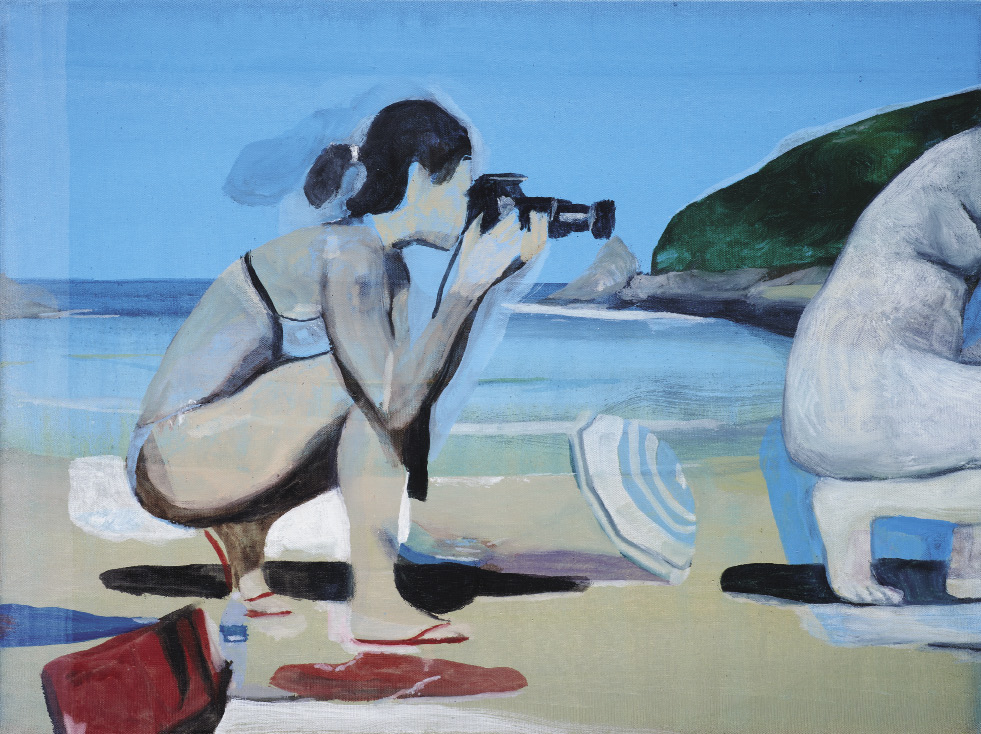| Go to the table of contents | —by Cyril Skinazy | Lire cette page en français |

—Marc Desgrandchamps, courtesy Galerie Zürcher
In 1903 the German writer Wilhelm Jensen published “Gradiva”, a novel which enjoyed great success and a remarkable longevity in European culture. The book inspired a passionate interest among the surrealists and André Breton even opened an art gallery named after the work’s Romanesque character. Salvador Dalí and André Masson drew great inspiration for their paintings. Sigmund Freud, for his part, started a series of commentaries on the book and published “Delusion and Dream in Jensen’s Gradiva”, a pioneering text in the philosophical studies of literature.
The book tells the story of archeologist Norbert Hanold, who on a trip to Naples falls under the charms of a bas-relief in the National Museum of Archeology. From that time forward, “this walking woman”, sculpted in stone as an incarnation of the God Mars, became such an obsession for Hanold that he forgot his own existence. The following evening he dreamed he traveling in time and met a young girl in the ruins of Pompeii while Vesuvius was erupting. Deeply troubled by this dream, he decided to go to Pompeii, where he had an unexpected meeting.
It is worthwhile to note that this female silhouette in motion—a reality just as much as it was pure fantasy—found its way in my existence with a stunning punctuality.
One day, having followed a friend going to the Zürcher Gallery in Paris, I found myself asking the painter Marc Desgrandchamps about the recurrence of feminine images in his paintings. “I paint Gradivas”, he answered right away, “She who flourished while walking”.
I didn’t have to mull over his vague explanation before noting how much it corresponded with my own life because, I might as well admit, I had spend a great part of the recent years wandering the streets of Paris (and other cities as it happens) following and filming unknown women, svelte and magnetic, floating about town, Gradivas to be exact.
This German writer’s dream, like the works by painters in Lyon, reminds us that “she who walks” constitutes for the artist, through his talents of artistic representation, one of the most powerful realities so much so that even the face of this cinematic heroine would prove as just as fleeting as his way of working is stealthy. And to put this in relation with my own urban safaris, I have no fear in saying that through all those I followed, I sought the woman for whom I had conjured up a dream image in my own spirit.
In pictorial world of Marc Desgrandchamps voices can make themselves be heard despite their utter calm. This unusual territory made up of green, blue, brown and beige suggests a murky kind of silence, in which the characters stop speaking and seem to think from on high, that of the American painter Edward Hopper.
Among French artists who use their own snapshots to paint from, silhouettes are actors who mutter under their breath. Each picture is a scene in a movie, by a refined film director, as in “Pauline at the Beach” by Eric Rohmer, or “La Notte” by Michelangelo Antonioni.
The greatest of oil paintings, without trying to be sensational, end up completely lodged in one’s memory. Their movement is not only cinematic but sub-atomic, thanks to their creators’ talent for exciting the imagination and tearing down temporal barriers. From these subtle images, inhabited or not by Gradivas, spring forth parallel worlds.
In “Against the Grain”, a novel by Joris Karl Huysmans, the hero of the story seeks to rediscover the smells of his past. I had the pleasure of experiencing this kind of olfactory travel the first time I went to Cuba. It was so strong I thought I’d traveled one century back in time, when I was alive in a previous incarnation. Past dilapidated buildings with faded colors, a long walk along the waterfront in the middle of which, as in a painting by Marc Desgrandchamps, a young woman flourished while walking.
Marc Desgrandchamps is represented by the Galerie Zürcher: 56, rue Chapon, 75003 Paris; 01 42 72 82 20; 33 Bleecker Street, New York NY 10012; (212) 777-0790
—by Cyril Skinazy